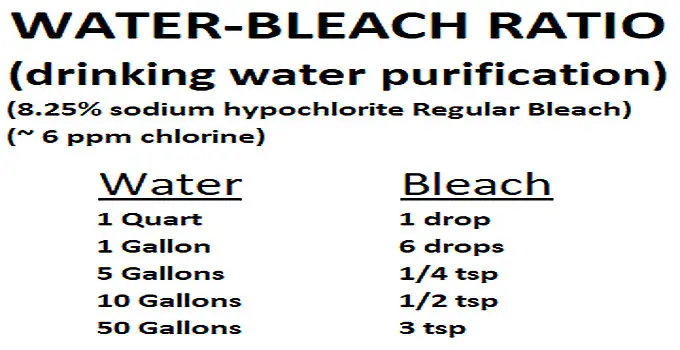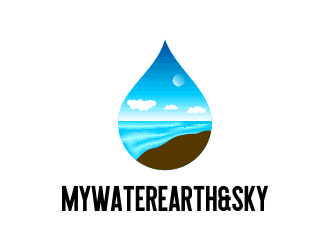In a time of crisis, or an emergency situation, water is the first thing that is needed for survival. With no drinking water available, we are dependent on drinking from sources that are questionable unless we purify it first. What are the methods for Purifying Drinking Water?
- Distillation
- Micro-Filtration using 1 micron or less
- UV Light
- Boiling H2O-Kills disease-causing Microbes
- Sodium hypochlorite-Disinfect 6-8.25% Household Bleach-6 drops per/gal
- Calcium Hypochlorite-add 16 oz. per 12.5 gals.
- Activated Charcoal
- 2% Iodine in liquid or pill –Aqua Tab chlorine dioxide tablets
If there is a big storm like a hurricane or possible flood on its way to your area, as a precaution fill up jugs or even the bathtub to make sure you have some water to work with just in case. At the very least you’ll have water that you still need to treat but will be able to drink if you have to.
Emergency Drinking Water
In an emergency situation where regular water service has been interrupted like a hurricane, flood, or water pipe breakage local authorities may recommend using only bottled water, boiled water, or disinfected water until regular water service is restored.
You should know how to boil water properly and disinfect water to kill most disease-causing microorganisms that may be present in the water. However, boiling or disinfection will not destroy other contaminants, such as heavy metals, salts, and most other chemicals. There are a few things to remember to prepare for the Drinking Water Emergency.
- Use bottled water or water you have properly prepared and stored as an emergency water supply. The bottled water has to be in the original package and in a cool dark area.
- Boil Water, if you do not have bottled water. Boiling is sufficient to kill pathogenic bacteria, viruses, and protozoa (WHO, 2015). If water is cloudy, let it settle and filter it through a clean cloth, paper towel, or coffee filter. Bring water to a rolling boil for at least one minute. At altitudes above 5,000 feet (1,000 meters), boil water for three minutes. Let the water cool naturally and store it in clean containers with covers. To improve the flat taste of boiled water, add one pinch of salt to each quart or liter of water, or pour the water from one clean container another several times.
- Sodium Hypochlorite-Disinfect Water with Bleach-Put one gallon of Bleach away in a dark closet in your home. if you can’t boil water. Only use regular, unscented chlorine bleach products that are suitable for disinfection and sanitization as indicated on the label. The label may say that the active ingredient contains 6 or 8.25% of sodium hypochlorite. Do not use scented, color safe, or bleaches with added cleaners.
- If water is cloudy, let it settle and filter it through a clean cloth, paper towel, or coffee filter.
- Locate a clean dropper from your medicine cabinet or emergency supply kit.
- Locate a fresh liquid chlorine bleach or liquid chlorine bleach that is stored at room temperatures for less than one year. Use the table on the next page as a guide to decide how much bleach you should add to the water, for example, add 8 drops of 6 % bleach or 6 drops of 8.25% bleach to each gallon of water.
- Double the amount of bleach if the water is cloudy, colored, or very cold. Stir and let stand for 30 minutes. The water should have a slight chlorine odor. If it doesn’t, repeat the dosage and let stand for another 15 minutes before use. If the Bleach is older use more of it- Shake it-Always let it sit-Smell it-The water should have a slight aroma of chlorine.
- If the chlorine taste is too strong, pour the water from one clean container to another and let it stand for a few hours before use. Or better yet smell the water if should have a light aroma of chlorine if it doesn’t then you should add a few more drops.
- If you add too much then shake the 1 gallon of water and the liquid sodium Hypochlorite will come out of the solution into the air. Agitation will take some of the Hypochlorite out of the solution.
Sodium Hypochlorite Water Treatment Dosage
 There actually is no difference! the bleach you use in your laundry is essentially the same as the bleach you use in cleaning the rest of the house. The only difference there might be is that sometimes you are using oxygen bleach, instead of chlorine bleach. Chlorine bleach is much stronger.
There actually is no difference! the bleach you use in your laundry is essentially the same as the bleach you use in cleaning the rest of the house. The only difference there might be is that sometimes you are using oxygen bleach, instead of chlorine bleach. Chlorine bleach is much stronger.
Sodium Hypochlorite is a liquid Chlorine and has around 10-12% available Chlorine. Available Chlorine (AC) is the amount of Chlorine released in the water to disinfect. Bleach, which contains Sodium Hypo, only has 5% AC which is why bleach is not a good pool disinfectant.
The active ingredient in household bleach is sodium hypochlorite, which is derived from salt. In fact, Clorox is headquartered in Oakland, California because we started making bleach here by running electricity through saltwater from San Francisco Bay! So household bleach begins and ends as salt and water.
During the laundering process, about 95 to 98 percent of household bleach quickly breaks down into oxidized salt and biodegradables, which is the primary reaction that makes it environmentally friendly. Clorox-What is Bleach
Calcium Hypochlorite For Drinking Water
- The first step is to calculate a chlorine solution that you will use to disinfect your water.
- For your safety, do it in a ventilated area and wear eye protection.
- Add one heaping teaspoon (approximately ¼ ounce) of high-test granular calcium hypochlorite (HTH) to two gallons of water and stir until the particles have dissolved.
- The mixture will produce a chlorine solution of approximately 500 milligrams per liter or mg/l
- To disinfect water, add one part of the chlorine solution to every 100 parts of water you are treating.
- This is about the same as adding 1 pint (16 ounces) of the chlorine solution to 12.5 gallons of water. If the chlorine taste is too strong, pour the water from one clean container to another and let it stand for a few hours before use.
- CAUTION: HTH is a very powerful oxidant. Follow the instructions on the label for safe handling and storage of this chemical-This is for an Emergency Only!
Chlorine Dioxide Drops
Chlorine dioxide is one powerhouse sanitizer that is getting more attention recently as food processors look for more efficacious products to help them win the sanitation battle. Approved by the U.S. Food and Drug Administration (FDA) and the U.S. Environmental Protection Agency (EPA), Bought here in liquid and tablet form sold on Amazon for Emergency Preparedness Water supply LIFESYSTEMS CHLORINE DIOXIDE LIQUID FOR WATER PURIFICATION (2X30ML)
- Safe for long-term use
- Do not leave any residual taste, odor, or color
- Treats up to 60 Liters of water
- Once opened use within 18 months
- Contents: Consists of 30ml Purifier and 30ml Activator
Aqua Tab chlorine dioxide tablets are suited to a variety of smaller applications, dissolving in around one minute and reaching full strength at five minutes. They can produce a range of concentrations, with a 4g Tab able to produce one liter of a 500 mg/L concentration. For larger applications, we offer Aqua-Dry kits that can create chlorine dioxide solutions in higher volumes and greater concentrations with a reaction time of only 10 minutes, allowing them to replace generators in many applications.
How To Activate Charcoal
Activated Charcoal can be bought and carried in powder or pill form like Chlorine Dioxide tablets or use the charcoal that remains from a campfire that can clean H2O that is poured through a homemade filter used to remove sediment. A filter should contain a layer of charcoal that is taken from a fire cooled and crushed. This will filter microbes that are dissolved in dilution. You can make it yourself from a campfire or buy find it on Amazon Coconut Shell Activated Carbon (Charcoal) for Bulk Drinking Water Grade (NSF/ANSI-61 Certified) Filtration Media
To produce Activated Charcoal,
- You will need to burn wood, coal, coconut shell, or bamboo without using oxygen using a metal can is the best way to limit the amount of oxygen it gets.
- Charcoal is activated using a chemical. The chemical of choice is calcium chloride (CaCl2) added to water, although zinc chloride (ZnCl2) can also be used and there’s a natural source called “lemon juice.” The citric acid in the lemon juice will activate the charcoal in the same way as calcium chloride or zinc chloride.
- Next, you will heat the product to a high temperature, thereby releasing some gases.
- Due to the spongy nature of this material, it’s known as Activated carbon.
Activated charcoal has a large surface area for binding any substance. Instead of absorbing toxins, it attracts toxic particles to its surface. In this video, they use a blender which you won’t have access to in the field instead just crush the Charcoal up in chunks, not powder. Activated Charcoal is safe to ingest and comes in pill form to help detox your body’s system to promote health.
Does Iodine Purify Water?
You may also use iodine to purify water, the iodine that can be found in your medicine cabinet or first aid kit. Add five drops of 2% tincture of iodine to each quart or liter of water that you are disinfecting. If the water is cloudy or colored, add 10 drops of iodine.
Stir and let the water stand for at least 30 minutes before use. Carrying iodine for water purification is not 100% perfect but is a lightweight solution for those in need of field purification of drinking water.
Kits are available in camping stores that include an iodine pill and a second pill (vitamin C or ascorbic acid) that will remove the iodine taste from the water after it has been disinfected. The addition of vitamin C, in the form of a pill or in flavored drink powders, precipitates much of the iodine out of the solution, so it should not be added until the iodine has had sufficient time to work. This time is 30 minutes in relatively clear, warm water, but is considerably longer if the water is cold. So it’s recommended to let it sit for a while after treating it.
Crystal clear water, running through a stream or river, does get cleaned a bit by natural processes flowing over rocks, vegetation, and other natural filters. But, if your drinking water is just downstream of any unknown water source, it could very well be contaminated by humans or animals and what may seem to be very clean and pristine may not be. Read our article here on MyWaterEarth&Sky called How do you tell if water is safe to drink in the wild?

JimGalloway Author/Editor
References: EPA- Emergency Disinfection of Drinking Water
EPA- Drinking Water Contaminants – Standards and Regulations



